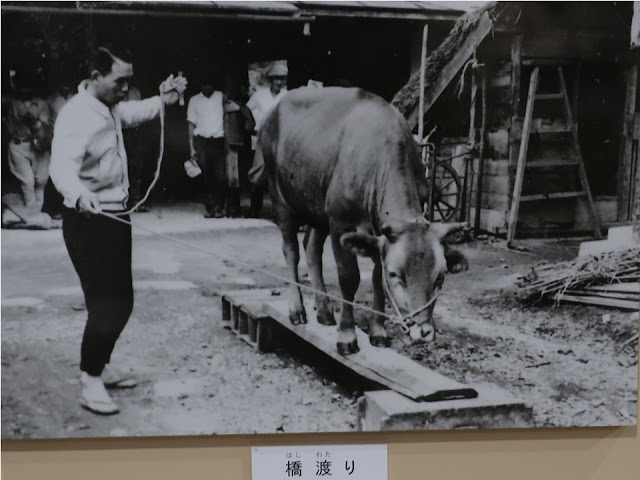It says that a cattle themed museum is
rare all over the world. It is located at Oshu city in northern Japan,
where is a producing area of Maezawa-gyu (Wagyu branded beef). Cattle
have brought us significant wealth. The museum shows us the cultural aspects
and the biological aspect of cattle. They are not only our food but also our
colleagues, I think.
世界的にも珍しい牛専門博物館だそうです。盛岡は前沢牛の産地です。人類に大きな富をもたらしたという牛を人文科学と生物学の両面から捉えています。牛は、食糧としてだけでなく、仲間としても、人と関係してきました。
Maezawa-gyu welcomes us in the exhibition room. There are several conditions to gain the Maezawa-gyu brand such as the raising time in Maezawa in Oshu city is the longest.
展示室に入ると、前沢牛が迎えてくれます。一生のうち、奥州市前沢区内での飼育期間が最長であることなどの条件を満たした牛が「前沢牛」を名乗れます。
“Kuroko” was born at a breeding farm in western Japan, then it was sent to a fattening one in Maezawa. The breeder’s daughter attached the letter to Kuroko in order to ask the fatting farmer to take good care. He warmly replied the letter and promised her to grow it kindly.
クロ子は、島根の繁殖農家で生まれ、前沢の肥育農家で育てられました。少女は、「牛を大切にしてね」と手紙を付けてクロ子を送り出したそうです。肥育農家も返信したという温かいやり取りです。
Cattle as creatures、生物としての牛
Cattle in the world are displayed. Japanese Black which become popular Wagyu-beef was produced by crossing of imported cattle onto domestic ones after late 19th century. I didn’t know it.
世界中の牛についての展示です。黒毛和種などの和牛は、明治以降に輸入された外国の品種と、在来の牛との交配だそうです。知りませんでした。
Cattle and people、牛と人とのかかわり
Some cattle which have been worshiped and others which have been partners of people are introduced in this area. Cattle and people have been alive together, I find.
精神的なよりどころとして信仰されている牛、人のパートナーとしての牛が紹介されています。一緒に暮らしてきたんですねえ。
The cow costume above is used in Gaungaun festival in Kagoshima (southern Japan). It is held on the 2nd of February in the lunar calendar. People pray for the good harvest; women and children chase the cow. It is said that the cow is perhaps an incarnation of a rice field god.
鹿児島のガウンガウン祭の牛。旧暦2月2日に五穀豊穣を願って行われる行事で、牛を女性や子供が追いかけます。牛は田の神の表現ではないかといわれているそうです。
The costume above is for cattle which take part in Mibu rice planting ceremony in Hiroshima (western Japan). It is written “Nou (agriculture) Hou (treasure)" on the saddle. We can understand how much people have cherished their cattle.
世界遺産に登録された壬生の花田植の牛の衣装。鞍に「農宝」と書かれていて、如何に牛が大切かが分かります。
A cow, a horse and a centipede which all are made of straw are used in Nogami festival in Nara (central Japan).; people pray for a good harvest.
奈良・天理市の野上祭では、麦で作った牛、馬、ムカデが登場し、豊作を祈ります。
In Takura ushigami sha (shrine) in Okayama (western Japan), people offer pottery cattle when their wish comes true. It's rare custom.
岡山県の田倉牛神社では、願いが叶った時に焼き物の牛を奉納します。
Monkeys are guardians of cattle and horses, therefore its skull or hand bone used to be hung on a cattle barn or a stable. It’s scared.
猿の頭骨や手の骨を、厩や牛舎に飾る厩猿(うまやざる)。これは、牛馬の守り神です。今は見られないそうです。ちょっと怖いですね。
An Ema wooden board of cattle was sometimes hung next to the monkey bone.
絵馬なのですが、牛です。厩猿の隣に、牛の絵馬を祀ったこともあったそうです。
Ofuda paper talismans for the safety of cattle are often delivered together with monkey talismans.
御札も厩猿と一緒に祀られることが多かったそうですよ。
Cultivation by a cow (Kuchinosima ushi in Kagoshima prefecture). Btw, it is written that the cow is wild one, it is not for farming.
犂(すき)を曳いて耕す牛です。牛は鹿児島の口之島牛で、農耕牛ではなく野生の牛でした。
A cow carries lumber (the photo was taken in 1959). It is hard labor! It seems that the cattleman abuses the cow. It says that cattle were more useful than horses because they could carry lumber. The cow is carrying 800 kg of wood.
木材を運ぶ牛(1959年撮影)。これは無理でしょ、虐待に見えます。木材を背負える牛は、馬よりも有用だったと言います。この牛は800kgの木材を背負っています。
There were roads on which cattle carried load such as salt, rice, charcoal, timber, ore, seafood and so on. Cattlemans in this region (Nanbu) made cattle carry iron ore and went to blacksmiths in central Japan. They sold ore to blacksmith and cattle to farmers. Then they went home empty-handed.
A cattleman walked around 40km a day together with six to ten cattle in summer when there were weeds to eat. It took more than twenty days to reach Nagano. It was an important mean of transportation before railways prevailed.
牛が塩や米、海産物、鉄鉱石などを運んだ牛の道がありました。南部の牛方は、鉄を背負わせ関東甲信越へ行き、鍛冶屋で鉄を売った後、牛を農家に売って手ぶらで帰ったそうです。
餌になる草が茂っている夏の旅で、牛方は、6~10頭の牛と、一日40kmぐらい歩いたそうです。信州までは20日以上の道のりでした。鉄道が開通するまで見られました。
Shoes for cattle; everything regarding cattle are exhibited here.
牛の履き物。牛のことは何でも展示されています。
People trained cattle to work together in the agricultural field.
牛に農耕をしてもらうためには、調教が必要でした。
Cattle made efforts. 牛さん、頑張ってます。
Local toys、郷土玩具
There are many cattle themed toys. Aka(red) beko(cattle in a local word) is famous.
牛をテーマにしたものは多数有ります。人気者の赤べこ(会津)には、黒いのもいますよ。
Various culture about cattle in the world、世界各地の牛文化
世界のカウベル。高低様々な音色でおもしろい!
After serving out roles, cattle are transformed to crafts. Their horns and cowhides are useful.
牛の工芸品。役目を終えた牛は、皮や角が身の回りの品になります。ありがたいですねえ。
Cups above are made of horns. Cool!
牛の角のコップです。いい出来ですねえ。
Other info about cattle、その他の展示
We had “Maezawa gyu Shabu-shabu lunch" at a restaurant called “Ushi (cattle) no Sato (village)”. Good!
近くで前沢牛のランチをいただきました。満足。
Sashimi beef (raw beef)、こちらは牛刺し
Visited in November, 2020
Official website: http://www.city.oshu.iwate.jp/htm/ushi/18_english/main.html
http://www.city.oshu.iwate.jp/htm/ushi/
(in Japanese but many info), accessed in
August, 2021
Previous post (Folklore museum specialized in Oni in the same prefecture):
Next post (The
largest museum in the neighboring prefecture):
Fukushima Museum、福島県立博物館 (Coming soon)

































Comments
Post a Comment